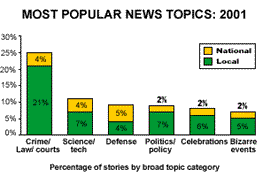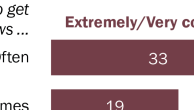By Lee Ann Brady and Atiba Pertilla
When you look at the numbers, it is difficult to conclude that local television news gives citizens the information they need to make informed decisions about their communities.
Consider this statistic: one has to add up all the educators, school board members, city council members, mayors, state agency officials, state legislators, governors, members of Congress and all other local elected and appointed officials combined just to match the number of criminals and suspects on screen.
Local TV news can vary widely from place to place in quality and sometimes in style. Our highest-scoring station, KULR in Billings, for instance, earned nearly twice as many quality points (424) as our worst station, WSOC in Charlotte (227 points).

News Director (and anchor) Blaire Martin of top-scoring station KULR in Billings with co-anchor Tim Vendt
But the mix of stories is remarkably consistent across the country, and the tone is generally breathless, chatty, and superficial.
Here are some numbers:
- Forty percent of the stories last 30 seconds or less.
- One in four stories is about crime, law or courts.
- Less than 1 percent of stories could be called “investigative.”
- Health stories outnumber all other social issues by 32 percent.
- There are as many stories about the bizarre (8 percent) as there are about civic institutions.
An important part of the picture is what’s missing. Poverty, welfare, and homelessness are all but absent in local news. Out of the nearly 6,000 stories studied, only nine dealt with these topics, not enough to even register a single percentage point.
Cultural events are another topic that barely rates coverage. A recent report from the National Endowment for the Arts found that citizens spend more money each year attending performing-arts events than either the movies or professional sports.
Yet on local TV news, the arts and culture are almost invisible, accounting for just 24 stories – again, less than one percent of the total studied.
Who are the people shown in local TV news stories? After criminals and suspects (who make up 10 percent of all people on screen) the next most common group featured is crime victims or their families (9 percent).
But this focus on victims, perhaps to manipulate viewers’ emotions, is unwise. Stations doing well in the ratings are the least likely to broadcast interviews featuring victims or victims’ relatives.
Big City vs. Small-Town News
Crime is the perennial No. 1 topic, in large markets and small, but in the largest markets stations are most likely to pad their crime coverage with tales of mayhem from distant places.
Stations air stories about economics, social issues and scientific or consumer matters at almost the same rate regardless of market size.
Regardless of the topic, however, small market stations are far more likely to tell the story from a local perspective (98 percent of stories) compared to the largest markets (69 percent).
Minorities are more likely to appear in large markets, but this may be changing with increased immigration to small cities.
What small-market stations do more than larger markets is cover stories affecting major community institutions or employers, perhaps because small metropolitan areas are less economically diverse.

Politics, Policy or Scandal
Coverage of politics, policy and government fell by nearly half from last year’s presidential primary season, down to just 8 percent of all stories. The bigger problem is that the politics that were covered seem fairly trivial now.
Our sample period included weeks when Congress was debating a massive tax cut and President Bush was promoting his plans to rebuild the military. But the scandals surrounding President Clinton’s departure from office made for much more popular material, outweighing coverage of the tax plan 5 to 1.
In all, only 16 stories out of nearly 6,000 discussed the tax-cut debate in Washington or its possible effects on the local community.
Going Global
This year, our study also coincided with two international incidents involving the military – the sinking of a Japanese fishing boat by a Navy submarine and the collision of a U.S. EP-3 spy plane with a Chinese fighter jet. As a consequence, defense issues jumped to the No. 3 topic on local newscasts. Although our sample included four stations in Honolulu, the home base of the submarine involved in the sinking, these stories were covered heavily throughout the country. This may be a sign that when public concern demands it, a national story will capture the attention of local TV, overriding the “local-only” mantra that so many stations promote.
Unfortunately, the data point to unsettling conclusions. Despite the increased coverage of defense issues, there is little energy or imagination evident on the air.
Just 12 percent of all defense stories were based on breaking news. Nearly twice that, 23 percent of the stories, were news conferences, and 43 percent were covered using feed material. About half these stories connected the national story to the viewing audience, but local stations were almost equally likely to simply pass along the latest updates without explaining their local effects. The locals mostly duplicated the networks rather than supplementing them with more nuanced, original coverage.
The events of September 11 will present an even greater challenge. The demands of a prolonged war on terrorism, much of it to be fought in covert operations in far-off countries, will strain already decimated newsroom budgets.
The nation looks to local news for information. A poll by the Pew Research Center this summer found that local news stations were a more popular news source than the networks, though not as popular as cable channels. But there is reason to worry whether newsrooms will prove deserving of the public’s confidence.
Lee Ann Brady is senior project director at Princeton Survey Research Associates. Atiba Pertilla is a research associate at PEJ.




